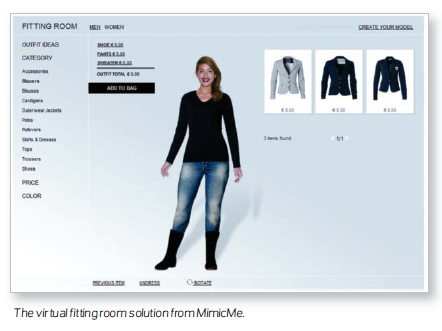Inside the Virtual Fitting Room

Ever take ten garments into a fitting room, just to come out with only one that fits?
This common occurrence proves that most clothing-related purchasing decisions are made inside fitting rooms - which poses a big problem for clothing retailers on the Web.
Perhaps the most profitable ecommerce category, apparel can also be the most challenging for merchants due to consumer uncertainties of how an online image translates into the right size, fit and look. However, new technologies are attempting to remedy this problem by providing ecommerce retailers with "virtual" fitting rooms.
These solutions allow consumers to virtually "try on" clothing with a custom model before hitting the checkout - which, according to one provider, can yield three times as many conversions and lower return rates by nearly 30 percent. Virtual fitting rooms also provide customers with an increased lifetime value by ensuring that they receive the desired look.
"Fashion is one of the most emotional purchases," says Heikki Haldre, CEO of Fits.me. "And customers do not want to purchase the right to return an item. They want to buy clothes that fit."
Integrating one of these platforms into an ecommerce site better allows retailers to be able to meet that need for online consumers, but they must first understand the specific benefits that each solution can provide. So, let's step inside some virtual fitting rooms and see what these innovative technologies have to offer.
MimicMe
This virtual fitting room enables consumers to mix and match clothes, shoes and accessories with a customizable model. The solution generates a fully digitized 3D garment based on two existing images - one front view and one back view. It can be seen in action at www.quizclothing.co.uk and www.menatwork.nl.
This solution can be integrated into any existing website and all ecommerce platforms. Once it is integrated, the fitting room is served from a GPU-based infrastructure and runs on all devices without a plugin, including desktops, mobile phones and tablets.
One of this solution's selling points to merchants is that MimicMe enables consumers to sample large amounts of retailers' inventories in a timely fashion. The company says that 20 percent of online visitors try on more than 25 garments per visit.
"Visualizing how items match together increases desire and makes people eager to complete a look," says Xavier Baars, founder and CEO of MimicMe. "This is the main advantage over augmented reality solutions, where in the same amount of time people can hardly view a handful of items."

My Virtual Model
This virtual fitting room can be integrated into an ecommerce site through the solution's Application Programming Interface (API). Similar to MimicMe, My Virtual Model can use merchants' existing apparel pictures and only requires two photos per garment - a front and back view - in order for consumers to see how they fit from all angles. This solution supplies the final images of the models wearing each outfit, but the buttons, images and links around the models are under the control of the retailer.
The API enables the images of the models to be rendered in multiple sizes, which can then be placed into any product page, doesn't recommend what size a customer should buy, it focuses category page or promotional Web page. While the solution exclusively on the visualization of outfits on different body shapes. The API also allows for personalization of the model's body shape and appearance, as well as allowing for dressing, undressing and turning of the model, and background changes. The virtual outfitting tools can also be used for mobile apps.
The company claims that My Virtual Model not only lifts conversion rates for retailers but that average order values (AOV) can also be raised by up to 200 percent.
"People using My Virtual Model spend on average 10 minutes on the site and try on an average of eight items," says Gregory Saumier-Finch, general manager of My Virtual Model.
Fits.me
Unlike the previous options, this solution focuses solely on fit and size.
Fits.me uses shape-shifting robotic mannequins to display how clothes will look on various body types. The solution requires that retailers send them samples of clothing in various sizes, and photos are taken of how the clothing appears during the robot's permutations.
On average, about 2,000 photos are taken of each garment and the images are stored and served from cloud servers. When consumers visit a retailer's site, they input their measurements and are shown the corresponding photos that match their clothing selections and body types - accurately depicting how each garment will look on individual shoppers.
"It's hard enough for online shoppers to wait for their items to arrive in the mail," says Haldre. "Therefore, it is important for the brand that customers not need to return them."
Try it on for size
While there are many other virtual platforms such as Styku, Zugara and Mipso - some of which are in the augmented reality or body-scanner realm - it is important for merchants to review each solution before choosing which solution "fits" best. But the ability to provide consumers with depictions of how items will appear on their bodies should ultimately increase sales, lower return rates and keep customers returning to "try on" something new.
About the Author: Allison Howen is an associate editor at Website Magazine, writing primarily about ecommerce and social media.








